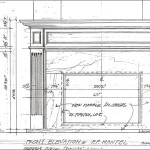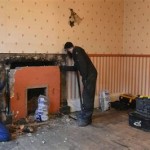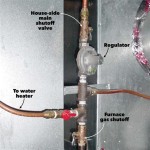Cost of Replacing a Gas Fireplace with a Wood-Burning Fireplace
The decision to replace a gas fireplace with a wood-burning fireplace is a significant undertaking, laden with considerations extending beyond mere aesthetics. While the allure of a crackling wood fire and its associated ambiance is undeniable, the financial implications, structural requirements, and regulatory hurdles require careful evaluation. This article will delve into the various cost components involved in such a conversion, providing a comprehensive overview intended for homeowners contemplating this transition.
The primary cost factor is, unsurprisingly, the installation of the wood-burning fireplace unit itself. The price range for these units varies considerably depending on several factors, including the size, brand, material, and features of the fireplace. Entry-level models, typically constructed from steel or cast iron, can be found at a lower price point. More elaborate and larger units, often featuring intricate designs and higher heating capacities, will correspondingly command a premium. This initial cost must be factored against the perceived benefits and long-term value the homeowner anticipates from the wood-burning fireplace.
Furthermore, the existing gas line will likely need to be capped and removed, adding to the overall expense. Disconnecting a gas line is not a task to be undertaken lightly and should always be performed by a qualified professional to ensure safety and compliance with local codes. Attempting to handle this task without proper training and certification carries significant risks, including gas leaks and potential explosions. Therefore, obtaining a professional assessment and quote for this aspect of the conversion is paramount.
Before embarking on the replacement process, it’s crucial to acknowledge the potential impact on the homeowner's insurance policy. Switching from a gas fireplace, generally considered a safer option, to a wood-burning fireplace can potentially increase insurance premiums. Insurance companies assess risk based on various factors, and the presence of an open flame and the associated risks of chimney fires can lead to higher premiums. Consulting with the homeowner's insurance provider prior to the conversion is advisable to understand any potential changes in coverage and cost.
Chimney and Ventilation Requirements
A properly functioning chimney is absolutely essential for a wood-burning fireplace. Unlike gas fireplaces, which often utilize direct vent systems, wood-burning fireplaces require a substantial and well-maintained chimney to safely vent smoke and combustion byproducts. The existing chimney, if present, must be thoroughly inspected to ensure it meets the requirements for a wood-burning appliance. This inspection should be conducted by a certified chimney sweep or qualified professional who can assess its structural integrity, flue size, and overall condition. Any deficiencies must be addressed before the fireplace can be safely operated.
If the existing chimney is unsuitable or nonexistent, a new chimney installation will be required. This is a significant expense and can be one of the most costly aspects of the conversion. The cost of a new chimney depends on several factors, including the height, materials used (e.g., masonry, prefabricated metal), and complexity of the installation. A tall chimney that extends well above the roofline will generally be more expensive than a shorter one. Similarly, a masonry chimney built from brick or stone will typically be more costly than a prefabricated metal chimney.
Furthermore, the installation of a chimney liner is often necessary, even if the existing chimney appears to be in good condition. A chimney liner is a protective barrier that helps to contain combustion byproducts and prevent them from damaging the chimney structure. Different types of chimney liners are available, including stainless steel and clay tile, each with its own cost and performance characteristics. The selection of the appropriate liner should be based on the specific requirements of the fireplace and local building codes.
Adequate ventilation is also a critical consideration. Wood-burning fireplaces consume a significant amount of oxygen, and insufficient ventilation can lead to poor combustion, smoke spillage into the room, and even carbon monoxide poisoning. Depending on the design of the home and the size of the fireplace, additional ventilation may be required. This could involve installing vents to provide fresh air to the fire or improving the overall ventilation of the room.
Installation Labor and Permits
The labor costs associated with installing a wood-burning fireplace can vary considerably depending on the complexity of the project and the prevailing labor rates in the area. Factors that can influence labor costs include the amount of demolition required to remove the existing gas fireplace, the modifications needed to the fireplace surround, the difficulty of installing the new chimney, and the amount of time required to connect the fireplace to the venting system. It's essential to obtain multiple quotes from qualified contractors to ensure a competitive price and a clear understanding of the scope of work.
Obtaining the necessary permits is a crucial step in the replacement process. Most jurisdictions require permits for fireplace installations to ensure compliance with building codes and safety regulations. Failure to obtain the required permits can result in fines, delays, and even the requirement to remove the fireplace. The cost of permits varies depending on the location and the scope of the project. It's the homeowner's responsibility to research local permitting requirements and obtain the necessary approvals before commencing any work.
During installation, building codes and safety regulations are meticulously enforced. These regulations cover various aspects of the installation, including clearances to combustible materials, chimney height requirements, and the proper installation of venting systems. Compliance with these regulations is essential to ensure the safe operation of the fireplace and to avoid potential fire hazards. A qualified contractor will be familiar with local building codes and will ensure that the installation complies with all applicable requirements.
Ongoing Costs and Maintenance
The initial cost of replacing a gas fireplace with a wood-burning fireplace is just one part of the equation. Homeowners should also consider the ongoing costs associated with operating and maintaining a wood-burning fireplace. One of the most significant ongoing costs is the purchase of firewood. The price of firewood varies depending on the type of wood, the quantity purchased, and the location. Seasoned hardwoods, such as oak and maple, are generally more expensive than softwoods, such as pine and fir. Purchasing firewood in bulk can often result in lower unit prices.
Regular chimney cleaning is essential for maintaining the safe and efficient operation of a wood-burning fireplace. Creosote, a flammable byproduct of wood combustion, can accumulate in the chimney over time. If creosote buildup becomes excessive, it can create a significant fire hazard. The Chimney Safety Institute of America (CSIA) recommends that chimneys be inspected and cleaned annually by a certified chimney sweep. The cost of chimney cleaning varies depending on the size and condition of the chimney.
In addition to chimney cleaning, regular maintenance of the fireplace itself is also important. This includes inspecting the firebox for cracks or damage, cleaning the glass doors, and ensuring that the damper is functioning properly. Any necessary repairs should be addressed promptly to prevent further damage and ensure the safe operation of the fireplace.
Furthermore, the homeowner needs to have a suitable area for storing firewood in a dry environment. Wood that is not stored properly can become damp and rot, making it difficult to burn efficiently. A wood shed or covered storage area is ideal for protecting firewood from the elements.
Replacing a gas fireplace with a wood-burning fireplace involves a complex set of considerations, each contributing to the overall cost of the project. Thorough research, careful planning, and the selection of qualified professionals are essential to ensure a successful and safe conversion. The initial investment can be substantial, but the long-term benefits of enjoying a crackling wood fire may outweigh the costs for some homeowners. Careful assessment of personal preferences, budget constraints, and environmental considerations is crucial in making an informed decision.

Estimated Page Fireplaces Stoves Inserts Wood Gas Pellet

How Much Does A Gas Fireplace Cost Fireplaces Direct Learning Center

How Much Does It Cost To Install A Gas Fireplace Homeserve Usa

Gas Vs Wood Fireplace Costs Maintenance Pros And Cons

Estimated Page Fireplaces Stoves Inserts Wood Gas Pellet

What Does It Cost To Install A Fireplace Vs Wood Stove Stamford Fireplaces

Fireplace Installation Cost 2024 Gas Wood Burning Electric

Gas Fireplace Cost Guide Unit Add Ons Installation More

What S The Cost To Convert A Wood Fireplace Gas Orange County Register

Want To Convert Gas Wood Fireplace Full Service Chimney
Related Posts








